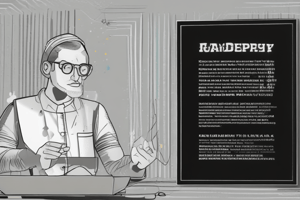Podcast
Questions and Answers
When did the Universal Declaration of Human Rights make specific reference to privacy as a human right?
When did the Universal Declaration of Human Rights make specific reference to privacy as a human right?
- 1981
- 1980
- 1995
- 1948 (correct)
Which of the following was the first legally binding international instrument in the area of data protection?
Which of the following was the first legally binding international instrument in the area of data protection?
- The OECD guidelines
- The Data Protection Directive
- The Council of Europe Convention 108 (correct)
- The General Data Protection Regulation
What was the basis for the UK data protection act 1998?
What was the basis for the UK data protection act 1998?
- The OECD guidelines
- The General Data Protection Regulation
- The Data Protection Directive (correct)
- The Universal Declaration of Human Rights
What was the purpose of the GDPR?
What was the purpose of the GDPR?
When did the GDPR become enforceable?
When did the GDPR become enforceable?
Flashcards are hidden until you start studying
Study Notes
- Privacy has historical roots in philosophical discussions, with Aristotle's distinction between public and private spheres of life.
- The Universal Declaration of Human Rights in 1948 made specific reference to privacy as a human right.
- In 1980, the OECD guidelines on the protection of privacy and transporter flows of personal data were introduced.
- In 1981, the Council of Europe Convention 108 was the first legally binding international instrument in the area of data protection.
- In 1995, the EU drafted the Data Protection Directive, which was the basis for the UK data protection act 1998.
- The directive was implemented throughout the European Economic Area, but each jurisdiction could interpret it differently.
- In 2012, the EU began an overhaul of the directive, resulting in the General Data Protection Regulation (GDPR) adopted in 2016.
- The GDPR became enforceable on May 25th, 2018.
- Prior to the GDPR, data privacy and protection were already important parts of legal frameworks since the Second World War.
- The GDPR aims to harmonize data protection laws across the EU and strengthen the rights of individuals regarding their personal data.
Studying That Suits You
Use AI to generate personalized quizzes and flashcards to suit your learning preferences.




